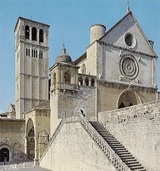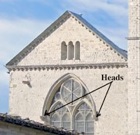
Pope Gregory IX
On 29 April 1228, in a papal bull "Recolentes qualiter", Pope Gregory IX announced his intention to build a "specialis ecclesia” (special church) to house the relics of St Francis. He also granted an indulgence of 40 days to those who made donations towards the cost of construction. He was embroiled in a political dispute with the Emperor Frederick II at this time, and imperial sympathisers had forced him from Rome, so this bull was issued at Rieti.
Gregory IX spent about two weeks in Assisi from 26th May, 1228 and then took up residence in Perugia. He canonised St Francis in Assisi on 16th July 1228 and laid the foundation stone of the new church on the following day. In the following year, in another bull also beginning "Recolentes qualiter", he took San Francesco under his protection and declared it to be papal property. (He stayed in Perugia until it was safe to return to Rome in February, 1230).
In 1230, in the bull “Is qui ecclesiam”, Gregory IX defined the church as the “caput et mater” (literally head and mother) of the Franciscan Order. This bull was addressed to the Minister General and the friars staying at San Francesco, “ in the place which is [now] called ‘Collis Paradisi’ (Hill of Paradise)”.
Brother Elias and the Construction of San Francesco
The man to whom Gregory IX entrusted the construction of San Francesco and the Sacro Convento was Brother Elias. He had joined the Order in ca. 1210 and had established the Franciscan convent at Acre in 1217. He remained in the east for about three years, and was reunited with St Francis during his mission to Damietta in 1219 and returned to Italy with him soon after. When Brother Peter Catanii died in 1221, St Francis chose Brother Elias as “mother to himself and ... father to the other brothers”. He was privileged to see the wound in St Francis’ side while the latter was still alive.
When St Francis died in 1226, Brother Elias remained at the head of the Order pending the election of a Minister General. He wrote an encyclical letter to the Order, in which he announced both the death of St Francis and the miracle of his stigmatisation. Brother John Parenti was elected as Minister General in 1227, leaving Brother Elias free to concentrate on the construction project at Assisi.
Brother Elias received land on behalf of Gregory IX on the "Collis Inferni" (Hill of Hell), a hill close to (although outside) the city walls. The donors were two citizens of Assisi:
-
✴Simone di Pucciarello; and
-
✴Monaldo di Leonardo, shortly after.
There are relatively few firm points of reference for the chronology of the construction of San Francesco:
-
✴The relics of St Francis were translated to the church from San Giorgio on (or perhaps just before) 25th May 1230. (See the page on the Crypt of San Francesco for the events of that day).
-
✴Brother Elias retired to a hermitage in 1230 to do penance for his part in what seems to have been an unruly attempt to remove the Minister General, Brother John Parenti. A document that no longer survives recorded that John Parenti, acting in the name of Gregory IX, then appointed Piccardus Morico to control the financial aspects of the construction of San Francesco and to work in collaboration with Filippo da Campello. (Filippo is sometimes said to have been the architect of the church, but it seems to be more likely that his role was purely administrative).
-
✴Brother Elias was rehabilitated in 1232 and elected as Minister General. He seems to have spent almost all of the next seven years at San Francesco, presumably overseeing its construction.
-
✴Gregory IX celebrated mass outside San Francesco (because of the size of the crowd) on the Feast of St Francis (4th October) 1235. Since he did not consecrate either of the high altars at this time, they were presumably not yet in place.
-
✴In 1236, Brother Elias commissioned a Crucifix from Giunta Pisano, probably for the Upper Church.
-
✴In 1237, brother Elias sent visitors (whom Brother Salimbene de Adam termed “extortioners”) to the provinces of the Order in order to raise further funds for construction, causing offence to those friars who wanted to follow St Francis in eschewing contact with money. Among other things the Provincial Ministers were “persuaded” to bear the cost of casting one of the six new bells for the church.
It seems likely that construction was largely completed during the period of comparative peace between Gregory IX and Frederick II in 1230-9:
-
✴The bust of a crowned head (presumably that of Frederick II) and a pope (presumably that of Gregory IX) survive on the outside of the window of the left transept of the Upper Church.

-
✴In 1238, as political tension mounted, Gregory IX sent Brother Elias to negotiate with Frederick II at Cremona.
-
✴The inscriptions on two of these bells nevertheless recorded that Brother Elias commissioned them in 1239, during the reigns of Gregory IX and Frederick II.
-
✴Frederick II was once again excommunicated at Easter, 1239.
Brother Elias became increasingly unpopular with a section of the Order, in part because of the financial demands he made of them in order to support the construction of San Francesco. His enemies persuaded Gregory IX to summon a General Chapter in Rome in 1239, during which he was deposed as Minister General. He seems to have remained at Assisi for the rest of 1239, but he then declared his allegiance to Frederick II and entered his service. He was excommunicated and expelled from the Order. When not at the imperial court he lived at Ghibelline Cortona, where he built the church of San Francesco, Cortona. He was reconciled with the Order and with the Church as he lay dying there in 1253, and was buried in his church of San Francesco there, which subsequently passed to the Order.
Hiatus (1239-53)
Open warfare between Gregory IX and Frederick II resumed at about the time of Brother Elias' deposition. His successor, Brother Albert of Pisa died after only eight months in office. The next Minister General, Haymo of Faversham, seems to have taken little interest in San Francesco and he certainly failed to leave any mark on it.
There seems to have been a hiatus in activity at San Francesco in the 1240s, except for the fact that, in October 1246, the Commune donated land in front of each of the two churches for two piazze. One reason for the hiatus was political: Gregory IX suffered a series of reverses in Umbria in the early stages of the war, and Assisi was inevitably caught up in the conflict. It was attacked by Imperial forces in 1240 and 1241, and many nearby cities defected or were taken. By the time of the death of Gregory IX in 1241, Perugia, Orvieto and Assisi were the only Umbrian cities still loyal to the papacy.
The papal throne was vacant for most of the following two years. Shortly after his election in 1243, Pope Innocent IV granted the rights and income due to the papacy in the diocese of Assisi to the secular authorities of the city, in gratitude for their fidelity. In 1244, he deposited the papal treasury at San Francesco before he fled to the safety of Lyons. These facts suggest that the city continued in its pro-papal affiliation: however, it seems that its bishop (whose name is unknown) was unable to reside in the diocese in the period ca. 1243-9, so there must have been other divisive factors in play.
There was also unrest within the Franciscan Order, which led to the deposition of the Minister General, Crescenzio da Jesi in 1247. It seems that the canons of San Rufino elected him as Bishop of Assisi shortly thereafter, but Innocent IV over-ruled them. Instead, he gave the post to Nicolò da Calvi, another Franciscan who was also his chaplain (and later his biographer).
Frederick II died in 1250, and Innocent IV returned to Italy in the following year. He spent the period from November 1251 until April 1253 at Perugia. He moved to Assisi for the following six months, during which time he:
-
✴consecrated the high altars of the upper and the lower churches (on 25th May); and
-
✴canonised St Stanislaus in the lower church (on 17th September).












